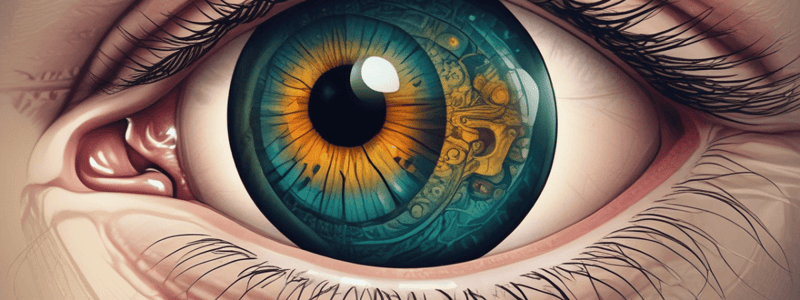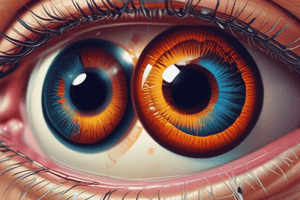Podcast
Questions and Answers
According to the Accommodative Lag Theory (2000), what stimulates eye growth?
According to the Accommodative Lag Theory (2000), what stimulates eye growth?
- Myopia
- Over-accommodation
- Under-accommodation
- Relative hyperopia (correct)
The level of defocus present on the image affects the number of microsaccades produced.
The level of defocus present on the image affects the number of microsaccades produced.
False (B)
What class of fixational eye movement is the largest?
What class of fixational eye movement is the largest?
Microsaccades
Excessive blinking can lead to a condition known as _____
Excessive blinking can lead to a condition known as _____
What is the focus of the image in the peripheral refraction theory?
What is the focus of the image in the peripheral refraction theory?
What is the result of under-accommodation during near work according to the Accommodative Lag Theory?
What is the result of under-accommodation during near work according to the Accommodative Lag Theory?
What type of retinal image is associated with the parvo?
What type of retinal image is associated with the parvo?
What happens to vision during saccades?
What happens to vision during saccades?
What is the effect of myopia on microsaccades generation?
What is the effect of myopia on microsaccades generation?
What is lid lag?
What is lid lag?
What is the purpose of fixational eye movements?
What is the purpose of fixational eye movements?
What is essential blepharospasm?
What is essential blepharospasm?
What can modulate fixational eye movement?
What can modulate fixational eye movement?
What is the result of treating myopia with plus at near according to the Accommodative Lag Theory?
What is the result of treating myopia with plus at near according to the Accommodative Lag Theory?
What is oculomotor apraxia sometimes accompanied by?
What is oculomotor apraxia sometimes accompanied by?
What is a possible cause of insufficient closure?
What is a possible cause of insufficient closure?
What is the explanation for the stability of perception despite the existence of fixational eye movements?
What is the explanation for the stability of perception despite the existence of fixational eye movements?
What is Hering's law related to?
What is Hering's law related to?
What is ocular blepharospasm caused by?
What is ocular blepharospasm caused by?
What can cause excessive blinking?
What can cause excessive blinking?
What is the consequence of under-accommodation during near work according to the Accommodative Lag Theory?
What is the consequence of under-accommodation during near work according to the Accommodative Lag Theory?
What is the primary difference between the Peripheral Refraction Theory and the Accommodative Lag Theory?
What is the primary difference between the Peripheral Refraction Theory and the Accommodative Lag Theory?
What is the role of microsaccades in the context of fixational eye movements?
What is the role of microsaccades in the context of fixational eye movements?
What is the relationship between myopia and microsaccades?
What is the relationship between myopia and microsaccades?
What type of retinal image is associated with the magno?
What type of retinal image is associated with the magno?
What can modulate fixational eye movements?
What can modulate fixational eye movements?
What happens to our visual experience during fixation?
What happens to our visual experience during fixation?
What is the explanation for the stability of perception despite the existence of fixational eye movements?
What is the explanation for the stability of perception despite the existence of fixational eye movements?
What is the treatment approach according to the Peripheral Refraction Theory?
What is the treatment approach according to the Peripheral Refraction Theory?
What is the result of a problem with vertical gaze centers?
What is the result of a problem with vertical gaze centers?
What is an example of Hering's law?
What is an example of Hering's law?
What is excessive closure of the eyelid associated with?
What is excessive closure of the eyelid associated with?
What is the cause of ocular blepharospasm?
What is the cause of ocular blepharospasm?
What is a possible cause of insufficient closure of the eyelid?
What is a possible cause of insufficient closure of the eyelid?
What is oculomotor apraxia sometimes accompanied by?
What is oculomotor apraxia sometimes accompanied by?
During which phase of eye movement is vision degraded?
During which phase of eye movement is vision degraded?
Flashcards are hidden until you start studying
Study Notes
Eye's Axial Length Control Theories
- Accommodative Lag Theory (2000): proposes that under-accommodation during near work leads to image focusing behind the retina at the fovea, causing relative hyperopia that stimulates eye growth, and can be treated with plus lenses at near, such as bifocals or PALs.
- Peripheral Refraction Theory (2020): suggests that shorter off-axis eye length and image focus behind the retina in the periphery leads to relative hyperopia, stimulating eye growth, and can be treated with plus lenses in the periphery.
Sampling of Retinal Images
- Parvo (fovea) and Magno (periphery) are two different types of sampling.
Fixational Eye Movements
- Small displacements of the eyeballs (tremor, drifts, microsaccades) ensure vision does not fade during fixation.
- Despite fixational eye movements, perception remains stable due to a hypothetical microsaccadic suppression mechanism.
- Fixational eye movements can be modulated by environmental (illumination conditions) and cognitive (attention) factors.
Saccades and Eye Movements
- Vision is degraded during saccades.
- Velocity (vertical gaze centers) problems can cause lid lag, such as in extrapyramidal syndromes.
- Lid retraction in the eye opposite to a ptosis is not a disorder, but an example of Hering's law.
Blepharospasm and Insufficient Closure
- Excessive closure (blepharospasm) can be due to ocular disease (e.g., dry eyes, uveitis, keratitis) or idiopathic essential blepharospasm.
- Insufficient closure can be caused by diseases affecting the facial nerve nucleus (somatic motor fibers), basal ganglia (Parkinson's), or frontal lobe lesions, affecting the ability to wink.
Eye's Axial Length Control Theories
- Accommodative Lag Theory (2000): proposes that under-accommodation during near work leads to image focusing behind the retina at the fovea, causing relative hyperopia that stimulates eye growth, and can be treated with plus lenses at near, such as bifocals or PALs.
- Peripheral Refraction Theory (2020): suggests that shorter off-axis eye length and image focus behind the retina in the periphery leads to relative hyperopia, stimulating eye growth, and can be treated with plus lenses in the periphery.
Sampling of Retinal Images
- Parvo (fovea) and Magno (periphery) are two different types of sampling.
Fixational Eye Movements
- Small displacements of the eyeballs (tremor, drifts, microsaccades) ensure vision does not fade during fixation.
- Despite fixational eye movements, perception remains stable due to a hypothetical microsaccadic suppression mechanism.
- Fixational eye movements can be modulated by environmental (illumination conditions) and cognitive (attention) factors.
Saccades and Eye Movements
- Vision is degraded during saccades.
- Velocity (vertical gaze centers) problems can cause lid lag, such as in extrapyramidal syndromes.
- Lid retraction in the eye opposite to a ptosis is not a disorder, but an example of Hering's law.
Blepharospasm and Insufficient Closure
- Excessive closure (blepharospasm) can be due to ocular disease (e.g., dry eyes, uveitis, keratitis) or idiopathic essential blepharospasm.
- Insufficient closure can be caused by diseases affecting the facial nerve nucleus (somatic motor fibers), basal ganglia (Parkinson's), or frontal lobe lesions, affecting the ability to wink.
Eye's Axial Length Control Theories
- Accommodative Lag Theory (2000): proposes that under-accommodation during near work leads to image focusing behind the retina at the fovea, causing relative hyperopia that stimulates eye growth, and can be treated with plus lenses at near, such as bifocals or PALs.
- Peripheral Refraction Theory (2020): suggests that shorter off-axis eye length and image focus behind the retina in the periphery leads to relative hyperopia, stimulating eye growth, and can be treated with plus lenses in the periphery.
Sampling of Retinal Images
- Parvo (fovea) and Magno (periphery) are two different types of sampling.
Fixational Eye Movements
- Small displacements of the eyeballs (tremor, drifts, microsaccades) ensure vision does not fade during fixation.
- Despite fixational eye movements, perception remains stable due to a hypothetical microsaccadic suppression mechanism.
- Fixational eye movements can be modulated by environmental (illumination conditions) and cognitive (attention) factors.
Saccades and Eye Movements
- Vision is degraded during saccades.
- Velocity (vertical gaze centers) problems can cause lid lag, such as in extrapyramidal syndromes.
- Lid retraction in the eye opposite to a ptosis is not a disorder, but an example of Hering's law.
Blepharospasm and Insufficient Closure
- Excessive closure (blepharospasm) can be due to ocular disease (e.g., dry eyes, uveitis, keratitis) or idiopathic essential blepharospasm.
- Insufficient closure can be caused by diseases affecting the facial nerve nucleus (somatic motor fibers), basal ganglia (Parkinson's), or frontal lobe lesions, affecting the ability to wink.
Studying That Suits You
Use AI to generate personalized quizzes and flashcards to suit your learning preferences.




